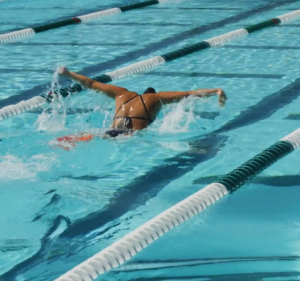Breathing Pattern in the 100 Butterfly
On the first day of the Olympic Trials, one of the most incredible swims was 18-year old Torri Huske, who ripped off a 55.78 in the semi-finals. Torri went out fast on her first 50 meters but showed no signs of fading at the end with a strong finish to the wall. One of the reasons we believe Torri was able to finish so strongly was her breathing pattern.
On her first 50 meters, Torri held a breathing pattern of one up and one down, a typical pattern that most women will try to maintain for the entire race. However, at the turn, after a long underwater to breakout, Torri changed her breathing pattern to mostly two up and one down. Those extra breaths likely made a difference in the final meters of her race. In the finals, she went out .3 seconds faster than in the semi-finals, then changed to mostly one up and one down on the second 50 meters and finished .2 seconds slower than in the semi-finals.
The energy derived in the first 50 meters is mainly from the anaerobic system, since the aerobic system requires about 20 seconds before it begins producing energy. Yet, for the second 50 meters of fly, most of the energy is derived from the aerobic system. Therefore, it makes sense to provide that aerobic system with more oxygen on the second 50 meters, since it depends on it.
Consider that the normal respiratory rate on land of an athlete using the kind of exertion required for a 100-meter butterfly would be 50-60 breaths per minute. With stroke rates typically in the mid 50’s, a one up, one down breathing pattern will result in a respiratory rate of around 25 breaths per minute, or less with the long underwater kicks. That breathing rate is not providing enough oxygen, nor ridding the body of enough carbon dioxide to get the job done. Usually, the result is a poor final 15 meters to the wall.
Every single swimmer is different. Some swimmers have higher VO2 Max and can handle hypoxia better than others. The swimmer increases frontal drag and propulsion by breathing in fly, resulting in a speed very similar to the non-breath stroke. The tradeoff of taking more breaths is between causing more drag vs. getting more oxygen- not always an easy choice. Either way, when the breath in fly is taken, it should be a low-profile breath, causing the least amount of increase in frontal drag.
As Torri demonstrated so well, the breathing pattern does not necessarily need to remain the same for the second 50 meters. World record-holding butterflier Sarah Sjostrom is also known for breathing much more on the second 50 than on her first 50 meters.
While the breathing rates in fly are very individual and controversial, at The Race Club, we are big proponents of breathing more often than one up and one down. This is especially true for men, who often produce lactate at a higher rate than women. After all, to finish the races well, oxygen is our best friend.
This week, we have a Race Club video, Breathing Patterns for the 100 Butterfly, that illustrates the options for breathing in the 100 butterfly races.
Yours in Swimming,
Gary Sr.
For the Most Advanced Swimming Technique Videos

